► A deep-dive on one of the Beijing show’s most interesting cars
► Focuses on families and interior space
► It’s what the Porsche 992 designer did next
The Beijing auto show felt more like a tech convention than a motor show, with hundreds of people gathered around shiny new products from brands you’ve probably never heard of.
But in the same way Xiaomi and Huawei (who now make EVs in China by the way) produce Android phones that look relatively similar to each other, all the EVs and range-extenders (which are particularly big in China) can turn into an analogous ball of mobility. That is, all except the Li Auto Mega.
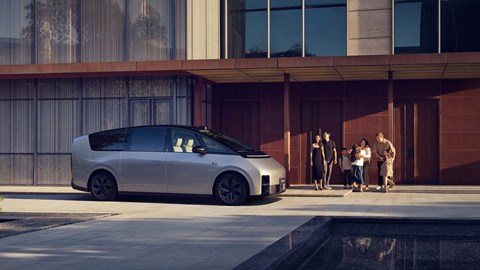
Penned by ex-Porsche designer Ben Baum (whose work includes the current Porsche 992), and with a brand mission closer to Apple than Ford, its sci-fi curves cut a rarely distinctive figure on the show floor. So much so, that we had to go and find out about Li Auto’s first full electric car.
The science behind the looks
It does! That comes from the super clean lines – a permanent fixture of Baum’s vision for Li Auto’s line-up – as well as the need for space and a range of at least 700km (CLTC) – no mean feat considering its 5350mm length, 1965mm width and 100kWh battery.
‘The only way we could solve this problem is to have a very, very low aerodynamic value: 0.215Cd. It’s a better drag coefficient than the Porsche Taycan (0.22 Cd), and that’s also enabled us to give it this really nice silhouette,’ he adds. A spec sheet reveals the Mega can achieve 710km CLTC from its 102.5kwh battery, so that’s mission accomplished.

As for CLTC? It’s short for China Light-Duty Vehicles Test Cycle – and it’s essentially the same as WLTP, with the main difference being that it’s carried out at lower speeds. As a result, the range figures it produces are usually around 10-15% more generous than the WLTP figures we’re used to.
Take the MG 4. It has a 425km (264 mile) CLTC range, and a 350km (217 mile) WLTP range. So all things roughly translated, the Mega can do around 350 miles on a tank.
Power comes from a 155kW motor at the front with 232Nm of torque and a rear motor with 245kW and 310Nm of torque. A combined 400kW and 542Nm means it’ll hit 0–62mph in an extremely unnecessary 5.5 seconds.
Standing out from the crowd

Of course, the Mega’s design isn’t borne from the wind tunnel alone, with some very deliberate styling touches that set the tone relatively new brand. ‘Our concept is Halo light, which means we see the front and rear as one Halo ring,’ Baum tells us on the busy show floor. ‘So that’s why the front light and the rear light [is] always connected on the same level.’
‘Many companies are having a [light bar] in the front now, but we really, really care that it’s not interrupted. It’s one single line. It has no cut lines in between so you can really read it.’

The Mega has black U-shaped area underneath the light bar, and it’s here that it hides all the autonomous-enabling technology you’d expect in a modern EV. It’s a neat idea and unsurprisingly feels like a very ‘Stuttgart’ solution.
At the rear, the Halo continues as a futuristic brake light, and it’s contained in a breadvan-like abrupt stop which ends the glasshouse mid-curve. ‘This is where the airflow separates, and it’s why we actually were able to get this very low drag coefficient,’ Baum explains.

‘For electric cars we added seamless to the brief,’ says Baum, who later explains how the popularity of Range extenders in China means this is the first non-REX car in the Li Auto line up. ‘It should be a very, very seamless car, everything should be integrated.’
What about the interior?
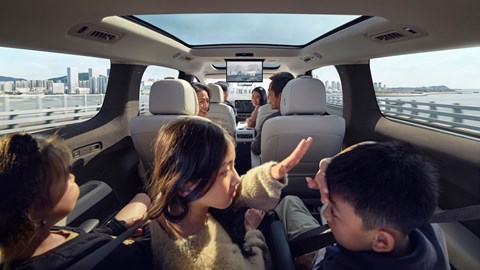
Space – along with price – appears to be a key metric for Chinese consumers and the Mega has this in spades. Open the Mega’s doors, and the interior feels bright and airy.
Creating a space for families is a key aim of the brand: ‘In the second row you have more space than a BMW 7-Series, and in the third row you have more space than a BMW 5-Series,’ Baum tells us. ‘It’s very spacious car, and it’s comfortable on all seven seats.’
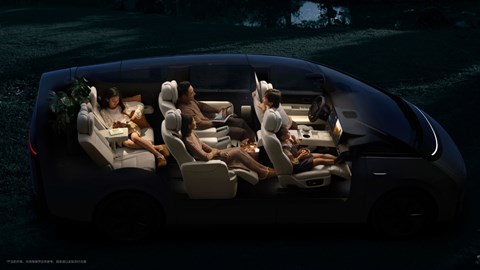
Tech is of course front and centre in the Mega, and it’s here to work for families: USB-C sockets and wireless chargers are on what feels like every flat surface, and bi-directional charging for camping trips and other situations.
There’s also a pair of 3K OLED 15.7-inch screens up front for the passenger and driver and, just behind them, the first row of passengers get a 17-inch OLED screen that flips down from the ceiling. The Mega backs up the sights with sounds too; it boasts a 2160 watt 21-speaker system, capable of Dolby Atmos for 3D sound.

The intelligent glue for all of this – as well as the Mega’s autonomous systems – is AI. ‘What really makes this brand is the artificial intelligence in the car,’ Baum reveals.
‘We have Mind GPT (an off-shoot of Chat GPT) inside). You can say open this window, you point at the window, and it opens the window, close this screen, open the screen, whatever. You can say I’m a little bit a little bit hot, and it will automatically turn on the AC and so on.’
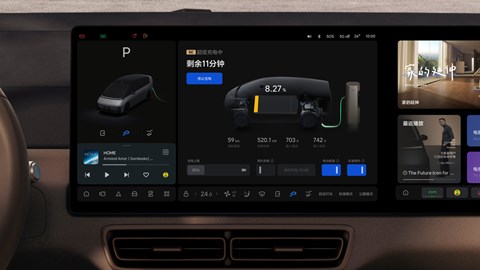
The Apple of automotive
It’s an impressive feature set for a car that retails at ¥529,800 Chinese Yuan or just under £60,000 in pounds. It goes big on both tech and styling, in that order, and that’s no coincidence; Baum explains that for Li Auto, a proper marriage between hardware and software is essential for the best product.
And a strong style is just as important to break through the new crop of similar looking EVs flooding the market. It’s no surprise, then, that in an EV market that increasingly feels like the smartphone one, Li Auto is following Apple’s example.
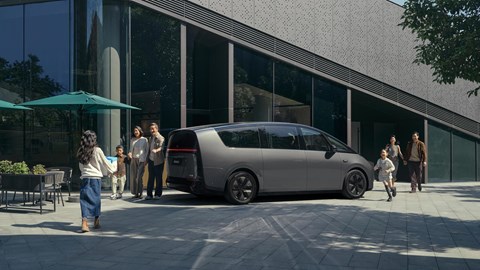
Baum says: ‘It’s very important to create a brand design language which works with the brand language as well and with the brand mission. If you’re not an established brand like BMW or Mercedes or Porsche, for example, you have to do that. Otherwise, people will not recognise you.
‘It’s kind of how Apple does their whole ecosystem. You will always see it’s an Apple product because everything works together: brand, mission, vision and design. We’re really trying to create something holistic. Sometimes it’s a bit hard, but I think we’re on the right path.’ We think so too.
Will it come to the UK?
Not right now.